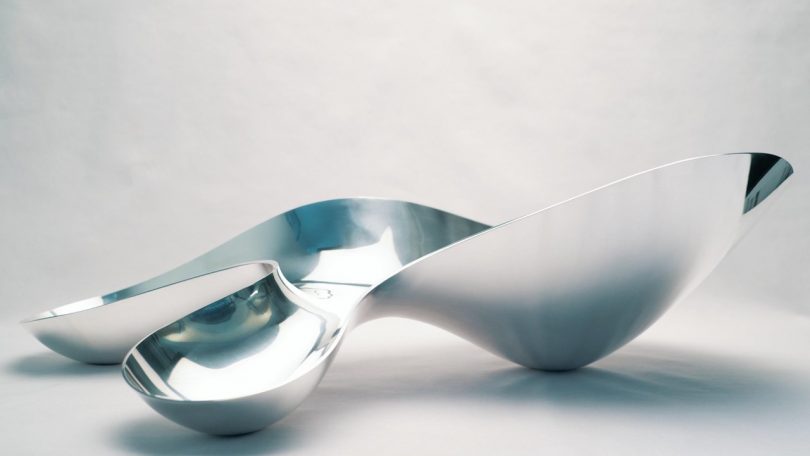We’ve been asked to honor non-disclosures and embargoes for a multitude of designs – usually products falling under the realm of technology, automotive, or other products following the ebbs and flows of the consumer market. But several months ago we were asked if we could keep a secret, one made by request and invitation from Danish brand, Georg Jensen. This was something entirely different.
The Copenhagen-based luxury artisan brand would reveal they had been secretly researching and resurrecting a previously lost design, an unrealized sculptural piece by designer Henning Koppel that would see a new life decades later in celebration of his life. It was called the 1041, a name without any real meaning beyond its archival numerical designation.
Nicholas Manville, Senior Vice President of Design and Merchandising at Georg Jensen will do a commendable job of building anticipation about the impending reveal, offering us a tour showcasing the skills of the company’s artisans, silversmiths, and even a resident 3D designer/printer all dutifully working on a myriad of limited edition handcrafted pieces. For those unversed in the history of Georg Jensen, the tour permits a valuable education about the artist-craftsman founder and company history, one documenting Jensen’s inherent fascination of natural forms derived from days spent in the idyllic countryside of his youth, eventually manifesting into a globally eponymous expression of modern silver and hollowware.
The tour will eventually plateau, literally, upstairs in the cozy and object-filled confines of the company’s archives located within an attic where photographs are only permitted from the tightest of angles, lest anyone reveal any geographical indicators of the priceless archive housed within. “Please, no windows in your photos…it could divulge where in the building this archive sits,” says Archivist Ida Heiberg Bøttiger.
Surrounded by decades of designs, art, sketches, jewelry and books dedicated to the brand’s storied history beginning in 1904, Bøttiger will rewind us back to 1954 – the date when Georg Jensen’s most famous and important designer Henning Koppel sketched “1041”, an organic expression, more sculptural than functional. Koppel would eventually destroy his abstract piece out of dissatisfaction after a single attempt to turn sketch into object.
The 1041 design was thought to be lost to history, the original sketch languishing forgotten in the Georg Jensen archives until 2016, when it was found again just in time before the Koppel centenary year. It’s discovery, alongside a single photograph of the sculpture made by Koppel before its destruction, would provide the modern artisans at Georg Jensen enough reference to ascertain Koppel’s original intent and realize a bit of “forensic design”.
Still, noting the previous limited resources and capabilities available in 1954, the resurrection of Koppel’s 1041 isn’t a perfect recreation, but rather a studied modern interpretation. 3D software and printing gave the Georg Jensen team tools Koppel could never even dream of decades ago, allowing a level of accuracy previously unavailable in manipulating silver upward and outward. The result is a stunning modernist expression evoking a cellular body in motion (the same technology, the different results, aided in the realizing of an exquisite level of detail across the Georg Jensen and architect Kengo Kuma collaborative tea set).

Ida Heiberg Bøttiger, Product Manager, Silver & Archive Manager at Georg Jensen, carefully shows us the numerical stamp adorning the very 1st Georg Jensen 1041. Photo: Gregory Han

Each 1041 is handled and crafted by a single Georg Jensen silversmith, hand-hammered from a single twelve-kilo sheet of fine silver to a width of 6mm at its thickest center, down to just 2mm at its edges. Silversmith Henrik Förster describes the process as tedious and demanding, but ultimately rewarding. Photo: Gregory Han
The Louisiana Museum of Modern Art would play stage for the reveal of the very first edition of the Georg Jensen 1041 by Henning Koppel, its undulating beauty unveiled amongst an intimate audience in May. Koppel’s own daughter, Hannah Koppel, would join us that afternoon in celebration of her father’s birthday and his body of work (she too is an accomplished Georg Jensen designer and sculptor by her own right), looking proudly upon her father’s past manifested into the present with the exacting level of detail he’d undoubtedly approve of.

Hannah Koppel would invite us to her childhood home which she still lives and works from today, populated by many of her own designs, alongside those designed by her father. Photo: Gregory Han
from Design MilkArt – Design Milk https://ift.tt/2OqreRT






No comments:
Post a Comment